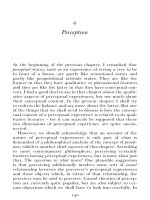An Introduction to the Grid
Bạn đang xem bản rút gọn của tài liệu. Xem và tải ngay bản đầy đủ của tài liệu tại đây (99.12 KB, 10 trang )
1
An Introduction
to the Grid
1.1 INTRODUCTION
The Grid concepts and technologies are all very new, first expressed
by Foster and Kesselman in 1998 [1]. Before this, efforts to orches-
trate wide-area distributed resources were known as metacomput-
ing [2]. Even so, whichever date we use to identify when efforts in
this area started, compared to general distributed computing, the
Grid is a very new discipline and its exact focus and the core com-
ponents that make up its infrastructure are still being investigated
and have yet to be determined. Generally it can be said that the
Grid has evolved from a carefully configured infrastructure that sup-
ported a limited number of grand challenge applications executing
on high-performance hardware between a number of US national
centres [3], to what we are aiming at today, which can be seen as a
seamless and dynamic virtual environment. In this book we take a
step-by-step approach to describe the middleware components that
make up this virtual environment which is now called the Grid.
1.2 CHARACTERIZATION OF THE GRID
Before we go any further we need to somehow define and char-
acterize what can be seen as a Grid infrastructure. To start with,
let us think about the execution of a distributed application. Here
The Grid: Core Technologies Maozhen Li and Mark Baker
© 2005 John Wiley & Sons, Ltd
2 AN INTRODUCTION TO THE GRID
we usually visualize running such an application “on top” of a
software layer called middleware that unifies the resources being
used by the application into a single coherent virtual machine.
To help understand this view of a distributed application and its
accompanying middleware, consider Figure 1.1, which shows the
hardware and software components that would be typically found
on a PC-based cluster. This view then raises the question, what is
the difference between a distributed system and the Grid? Obvi-
ously the Grid is a type of distributed system, but this does not
really answer the question. So, perhaps we should try and establish
“What is a Grid?”
In 1998, Ian Foster and Carl Kesselman provided an initial defi-
nition in their book The Grid: Blueprint for a New Computing Infras-
tructure [1]: “A computational grid is a hardware and software
infrastructure that provides dependable, consistent, pervasive, and
inexpensive access to high-end computational capabilities.” This
particular definition stems from the earlier roots of the Grid, that
of interconnecting high-performance facilities at various US labo-
ratories and universities.
Since this early definition there have been a number of other
attempts to define what a Grid is. For example, “A grid is a soft-
ware framework providing layers of services to access and manage
distributed hardware and software resources” [4] or a “widely
Sequential applications Parallel programming environment
Cluster middleware
(Single system image and availability infrastructure)
Cluster interconnection network/switch
Network interface
hardware
Communications
software
PC/
Workstation
Network interface
hardware
Communications
software
PC/
Workstation PC/
Workstation
Network interface
hardware
Communications
software
PC/
Workstation
Network interface
hardware
Communications
software
Sequential applications
Sequential applications
Parallel applications
Parallel applications
Figure 1.1 The hardware and software components of a typical cluster
1.2 CHARACTERIZATION OF THE GRID 3
distributed network of high-performance computers, stored data,
instruments, and collaboration environments shared across insti-
tutional boundaries” [5]. In 2001, Foster, Kesselman and Tuecke
refined their definition of a Grid to “coordinated resource shar-
ing and problem solving in dynamic, multi-institutional virtual
organizations” [6]. This latest definition is the one most commonly
used today to abstractly define a Grid.
Foster later produced a checklist [7] that could be used to help
understand exactly what can be identified as a Grid system. He sug-
gested that the checklist should have three parts to it. (The first part
to check off is that there is coordinated resource sharing with no cen-
tralized point of control that the users reside within different admin-
istrative domains.) If this is not true, it is probably the case that this
is not a Grid system. The second part to check off is the use of stan-
dard, open, general-purpose protocols and interfaces. If this is not
the case it is unlikely that system components will be able to com-
municate or interoperate, and it is likely that we are dealing with
an application-specific system, and not the Grid. The final part to
check off is that of delivering non-trivial qualities of service. Here
we are considering how the components that make up a Grid can
be used in a coordinated way to deliver combined services, which
are appreciably greater than the sum of the individual components.
These services may be associated with throughput, response time,
meantime between failure, security or many other facets.
From a commercial view point, IBM define a grid as “a standards-
based application/resource sharing architecture that makes it pos-
sible for heterogeneous systems and applications to share, compute
and storage resources transparently” [8].
So, overall, we can say that the Grid is about resource sharing;
this includes computers, storage, sensors and networks. Sharing
is obviously always conditional and based on factors like trust,
resource-based policies, negotiation and how payment should be
considered. The Grid also includes coordinated problem solv-
ing, which is beyond simple client–server paradigm, where we
may be interested in combinations of distributed data analysis,
computation and collaboration. The Grid also involves dynamic,
multi-institutional Virtual Organizations (VOs), where these new
communities overlay classical organization structures, and these
virtual organizations may be large or small, static or dynamic. The
LHC Computing Grid Project at CERN [9] is a classic example of
where VOs are being used in anger.
4 AN INTRODUCTION TO THE GRID
1.3 GRID-RELATED STANDARDS BODIES
For Grid-related technologies, tools and utilities to be taken up
widely by the community at large, it is vital that developers
design their software to conform to the relevant standards. For
the Grid community, the most important standards organizations
are the Global Grid Forum (GGF) [10], which is the primary stan-
dards setting organization for the Grid, and OASIS [11], a not-
for-profit consortium that drives the development, convergence
and adoption of e-business standards, which is having an increas-
ing influence on Grid standards. Other bodies that are involved
with related standards efforts are the Distributed Management
Task Force (DMTF) [12], here there are overlaps and on-going
collaborative efforts with the management standards, the Com-
mon Information Model (CIM) [13] and the Web-Based Enterprise
Management (WBEM) [14]. In addition, the World Wide Web Con-
sortium (W3C) [15] is also active in setting Web services standards,
particularly those that relate to XML.
The GGF produces four document types related to standards
that are defined as:
•
Informational: These are used to inform the community about a
useful idea or set of ideas, for example GFD.7 (A Grid Mon-
itoring Architecture), GFD.8 (A Simple Case Study of a Grid
Performance System) and GFD.11 (Grid Scheduling Dictionary
of Terms and Keywords). There are currently eighteen Informa-
tional documents from a range of working groups.
•
Experimental: These are used to inform the community about a
useful experiment, testbed or implementation of an idea or set of
ideas, for example GFD.5 (Advanced Reservation API), GFD.21
(GridFTP Protocol Improvements) and GFD.24 (GSS-API Exten-
sions). There are currently three Experimental documents.
•
Community practice: These are to inform the community of com-
mon practice or process, with the objective to influence the
community, for example GFD.1 (GGF Document Series), GFD.3
(GGF Management) and GFD.16 (GGF Certificate Policy Model).
There are currently four Common Practice documents.
•
Recommendations: These are used to document a specification,
analogous to an Internet Standards track document, for example
GFD.15 (Open Grid Services Infrastructure), GFD.20 (GridFTP:
1.4 THE ARCHITECTURE OF THE GRID 5
Protocol Extensions to FTP for the Grid) and GFD.23 (A Hierar-
chy of Network Performance Characteristics for Grid Applica-
tions and Services). There are currently four Recommendation
documents.
1.4 THE ARCHITECTURE OF THE GRID
Perhaps the most important standard that has emerged recently
is the Open Grid Services Architecture (OGSA), which was devel-
oped by the GGF. OGSA is an Informational specification that
aims to define a common, standard and open architecture for Grid-
based applications. The goal of OGSA is to standardize almost
all the services that a grid application may use, for example job
and resource management services, communications and security.
OGSA specifies a Service-Oriented Architecture (SOA) for the Grid
that realizes a model of a computing system as a set of distributed
computing patterns realized using Web services as the underlying
technology. Basically, the OGSA standard defines service interfaces
and identifies the protocols for invoking these services.
OGSA was first announced at GGF4 in February 2002. In March
2004, at GGF10, it was declared as the GGF’s flagship architecture.
The OGSA document, first released at GGF11 in June 2004, explains
the OGSA Working Group’s current thinking on the required
capabilities and was released in order to stimulate further discus-
sion. Instantiations of OGSA depend on emerging specifications
(e.g. WS-RF and WS-Notification). Currently the OGSA document
does not contain sufficient information to develop an actual imple-
mentation of an OSGA-based system. A comprehensive analysis
of OGSA was undertaken by Gannon et al., and is well worth
reading [16].
There are many standards involved in building a service-
oriented Grid architecture, which form the basic building blocks
that allow applications execute service requests. The Web services-
based standards and specifications include:
•
Program-to-program interaction (SOAP, WSDL and UDDI);
•
Data sharing (eXtensible Markup Language – XML);
•
Messaging (SOAP and WS-Addressing);
•
Reliable messaging (WS-ReliableMessaging);









